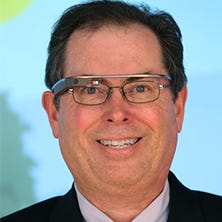Google Glass: Autocorrect For Your Life?
To offer the right assistance at the right moment, Google Glass will need workflow tech.

Recently, I demoed Google Glass to 30 people at a tech meetup. I did not stand in front of a room and project what I saw through Glass on a screen on a wall, though you can do that. For two minutes of Glass "facetime," folks stood in line. The last person waited, patiently, for an hour.
In every case, it was like a little light bulb went off over their heads, which, when you come to think of it, is not far from the truth. Afterwards the chatter was around: "How do I program it?" (HTML5 Web services or Java Android), "I've got a great idea for an app!" (Cool!), and, of course, "How do I get one?" (Wait until 2014, I believe). For all the chatter, pro and con, about Glass, you really have to try it on to get it.
Google Glass is a wearable computer prototype. It's not "glasses." It's Glass, singular. It is not an augmented reality transparent screen between you and your world. When it does appear, which is only a minority of the time you wear it, it appears like a ghostly 25-inch diagonal monitor floating above the fray. It responds to voice commands ("OK Glass"), head tilts (look up, it appears), and a touchpad on an arm along your right temple.
[ Check out 10 Great Gadgets From The Future. ]
If eyes are windows to souls, Google Glass is like a reverse peeping Tom -- a little daemon perched there, watching and waiting. In computer science, a daemon is a background process that wakes up when needed to perform some chore. In mythology, daemons are personal guardian angels that help and protect those whom they serve.
For what will Glass wait? That is indeed the six-point-four billion dollar question (conservatively!), if market size "spec"-ulations are plausible.
Currently, Glass feels a bit like Linux the first time I downloaded (32 floppy disks!) and installed it. Few apps then, but look at Linux now. (By the way, Glass is Android-based and Android is Linux-based.) Glass will only be successful, and I believe it will, if there are lots of compelling, fun useful apps, called Glassware, when it finally hits retail shelves.
Now, about that headline ... will Glass become the autocorrect for your life? There are more than two million hits for "autocorrect+funny" in Google. But, for the most part, smartphone autocorrect algorithms predict -- both correctly and usefully -- what we intend to type next. Instead of watching what you're typing, Glass will observe the series of actions you take to get through your day. This little daemon will be watching, learning, proffering, being rebuked, being instructed and, gradually, becoming a trusted, and then indispensable guardian angel.
That will be a bit creepy, sometimes unsettling and, occasionally, possibly, even dangerous. But I don't see any of that stopping intelligent, wearable, in-your-face tech, no more than downsides of trains, planes and automobiles stopped transportation technology.
In fact, Glass is the purest manifestation to date of what I have come to view as our shared digital meta-platform, a platform of platforms: social, mobile, analytics, cloud, workflow and language tech.
Social -- integration with Google+, Twitter, Facebook, etc.
Mobile -- as mobile as you are.
Analytics -- how do you think it learns what to do for you next?
Cloud -- of course.
Workflow -- see below.
Language -- "OK Glass, now ..."
Why Workflow Deserves A Place Here
Of the SMACWL technologies (social, mobile, analytics and cloud, to which I add workflow and language tech), only workflow really needs any defending for inclusion in an emerging meta-platform.
Workflow is a series of steps that consume resources (in this case, our attention) and achieve a goal. Workflow tech takes representation of executable workflow out of IF and CASE statements in computer code, and it stores that in a database for consultation and execution by a workflow engine. Some systems prescribe what users can do (think decision trees), while others focus on what users can't do (think constraints and violations).
Workflow tech increasingly relies on process analytics to learn what likely needs to happen next, so these systems can automatically proffer the right screen or voice command option at just the right moment. Sometimes -- it's increasingly true -- non-programmers can even inspect and edit these executable process models.
For Glass to be the raging success I believe it will be, many Glassware apps -- particularly in healthcare, the industry I call home -- will require sophisticated self-adapting and user-customizable filters, priorities and workflows.
In other words, if Glass really is going to be Autocorrect For Your Life, especially your professional life, it will also need to be Workflow For Your Face.
About the Author(s)
You May Also Like







